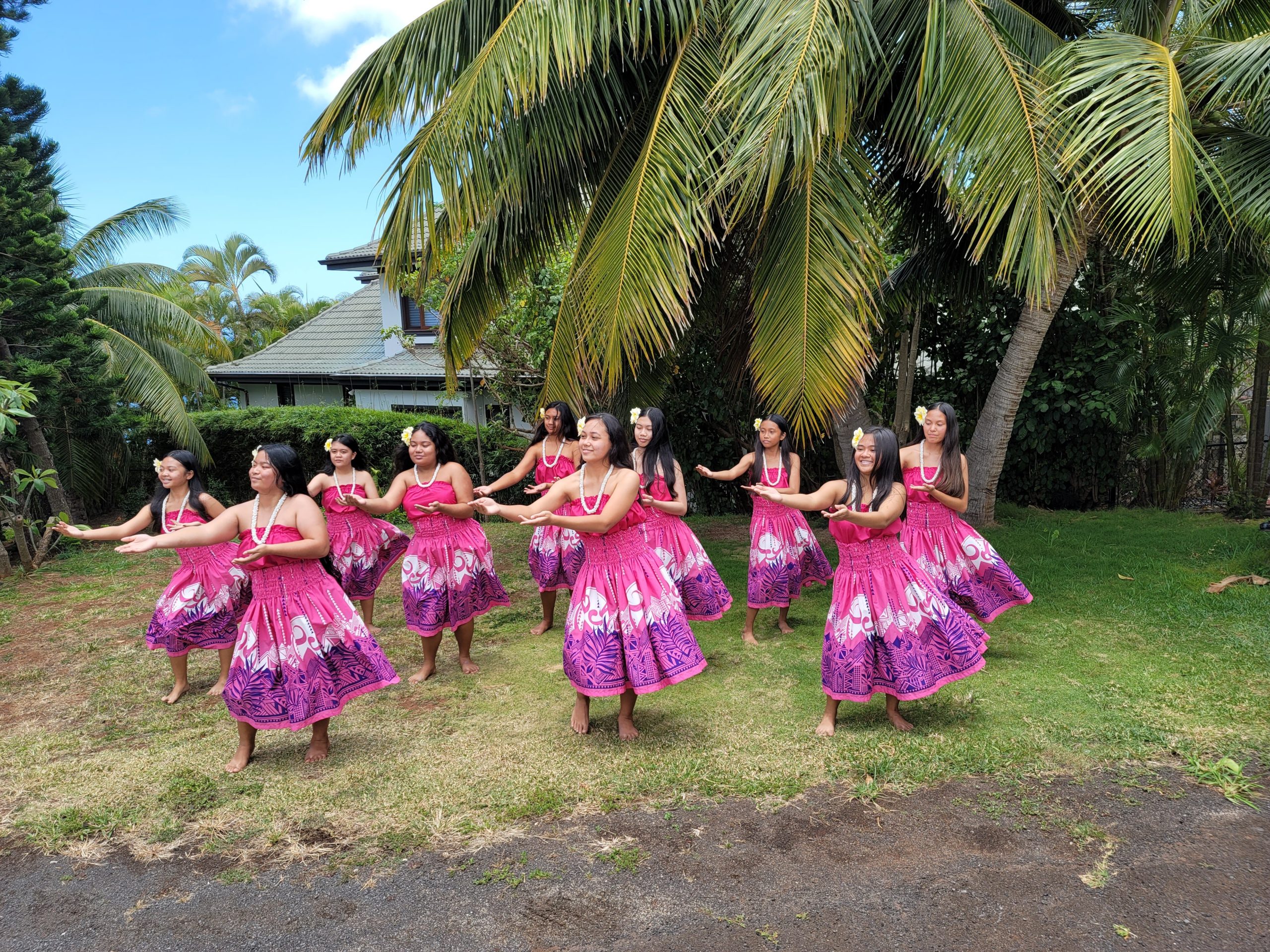
At the height of the COVID-19 pandemic, many throughout the dance industry gathered to discuss ways to navigate the challenges of the time while keeping everyone’s health and well-being at the forefront. The hula community was no different, and on August 17, 2020, an advocacy-based coalition of “kumu hula,” or hula teachers, convened to discuss a culturally proactive approach to the pandemic.
Beyond that, the coalition, known as the Huamakahikina, also began to address other challenges they were facing, namely, preserving and protecting what is deemed “hula” and who has the authority to teach it. Tourism, social media and platforms like YouTube have led to the abuse, misappropriation and commercialization of Hawaii’s state dance that have long needed to be rectified.
“It’s that thought that someone just learned hula at a workshop and now all of a sudden, they [think they] can start teaching hula themselves,” explains Kahealani Kamahele, a professor of Dance of Hawaii at Loyola Marymount University (LMU) in Los Angeles and owner of Hālau Hula O Kāhealani in Torrance, California. “You are seeing more videos on YouTube of people claiming to do ‘hula’ that is not hula, and it brings our traditions and our style of hula down.”
“There are so many people claiming to be a kuma hula and taking that name just because they danced in a luau [Hawaiian feast] for 30 years, for example,” says Kathryn Holoaumoku Ralar, kumu hula of the Na Pua O Kapiolani Hula Studio and the Napili Kai Foundation. “There is a difference between a dancer and a teacher.”
As luaus have also become a major tourist attraction in Hawaii, people can also confuse what hula is with other cultural dances, like Tahitian ʻōteʻa or Samoan fire knife dancing.
It was due to issues such as these that the Huamakahikina Declaration on the Integrity, Stewardship, and Protection of Hula was formed in August 2021. Over the course of two days during the Kupukalālā Convention (held virtually), 160 kumu hula from Hawaii, the mainland U.S., Japan, New Zealand, French Polynesia, France and Spain, convened to edit and ratify the declaration, which gained 201 signatures.

“The declaration is so important because there is so much that is unwritten and is passed on lineally,” says Kumu Hula Cody Pueo Pata, who served on the Leo Kāhoa Steering Committee for Huamakahikina and on the Strategy Support Team for the Kupukalālā Kumu Hula Convention. He is also the kumu hula of Hālau Hula ʻo Ka Malama Mahilani. “That’s part of the intellectual property rights mentioned in the declaration. Hula is not attainable unless it is from a lineally descended kumu hula, and anything that mimics hula, or doesn’t have a foundation in descendancy from a lineage, is not hula.”
More Than Dance
The Huamakahikina Declaration defines hula as “the multiplex of artistic, intellectual and spiritual practices, perspectives and products centered around the expression of Mele (song, anthem or chant) through the bodies of formally trained dancers. The Mele, the dancers, and their dance may each be referred to as Hula.”
For a kumu hula (who can also be referred to as kumu, aunty, uncle, loea, ʻōlohe, lehua, kahu and kahuna), hula instruction goes beyond teaching movement. At its core, it is the handing down of a heritage. To become a kumu hula, one has to train for many years after being carefully selected by their own kumu hula to carry on their respective style (although one does not have to be of native Hawaiian descent in order to be selected).
Kamahele’s grandmother, Ann McCabe from Kāneʻohe, Oahu, had her own hālau, or hula school, in California before moving back to Hawaii. Since McCabe never had any daughters, she chose Kamahele to learn hula. After moving to California in 1985 for college, Kamahele studied hula with her aunt, Kumu Hula Rolanda Mohala Reese. Aside from teaching her own classes at LMU and her hālau, Kamahele continues to learn under the tutelage of Kumu Hula Hōkūlani Holt, joining her weekly classes in Maui via Zoom and visiting the island about once a quarter.

Ralar has been a kumu hula for over 40 years, learning from her great grand aunt, Emma Farden Sharpe, one of the matriarchs of hula on the island of Maui.
Pata became a kumu hula after 10 years of intense study beginning at age 16 with Kumu Hula Nona Kaluhiokalani, her kupuna advisor Aunty Diane Nāpua Amadeo and Loea Hula George Nāʻope. Pata’s teachers also sent him to Kumu Hula Keʻala Kūkona to study ‘auana (modern style of hula) and falsetto singing, and to Kona on the island of Hawaii to learn from Kumu Hula Jay Ahulau Akiona and his masters—Loea Hula Hilda Keanaʻāina and Aunty Eleanor Kaʻupu Makida, from whom he learned haku mele (traditional lyric composition).
“Graduating” for these kumu hula goes beyond earning a certification. “Graduating in hula doesn’t follow the Western system,” explains Pata. “If I get straight A’s throughout my school career and you get straight C-minuses, we will graduate with the same certificate. Whereas in hula, we are only allowed to move forward if we have showed complete mastery in whatever subject it is we are expected to learn. So, by the time we graduate as kumu hula, all of our peers, teachers and community are certain that we’ve mastered whatever step was required of us.”
Ralar hopes to select a future kumu hula who can retain her style and pass it on to future generations. “I pray that they keep the style that I teach because I am one of the last kumu hula to teach this style,” she says. “If people see my dancers, they know it’s the Emma Sharpe style. If I go to a competition and I look at the dancers’ footwork and handwork, I can know that is the Nona Beamer style, [for example]. There are different styles and I want to make sure that whoever takes over after me keeps our style of hula alive.”
For someone who works at a university, like Kamahele, it’s challenging to encapsulate teaching years of tradition within just a single semester. Her Dance of Hawaii class was initially offered just once a week for three hours. Now that her class has been divided to two days a week for 90 minutes, she is able to dedicate the first 45 minutes of class to lecture and the last half of the class to dance. She is able to dive deeper, working with students at her own hālau, where her students range in age from 5 to 70. “My students are learning colors and how to count in Hawaiian,” she says. “I’m also starting to teach the teenagers the moon phases in Hawaii and what each phase represents, because the Hawaiian people followed the moon for a lot of planting and fishing.”

Another key to helping maintain the legacy of hula involves funding and providing dedicated spaces where hula can be taught. Pata says his own hula teachers were forced to be “migratory,” holding classes from their garage, a beach parking lot, high school gym and the Royal Lahaina Lūʻau grounds.
“Each place was completely different, so we had to be adaptable, and these places weren’t necessarily meant for hula practice,” recalls Pata, who lives and works on Maui. “On the flip side of that, some of my contemporaries today have their own studios, but two of them are paying between $3,500 to $4,300 a month just in studio rent. We don’t have that many students to even charge enough to cover those types of things.”
Inspired by the Huamakahikina Declaration, plans are moving forward to create more buildings for hula instruction, the first of which is the Hālau of ʻŌiwi Art, which is currently in the planning phase and can open on Maui as early as 2026.
A Lasting Legacy
Hula has maintained a rich heritage despite historical challenges dating back as early as the 1830s, when the practice of hula was outlawed in the Hawaiian Kingdom under the advice of Christian missionaries. Hula was maintained in private during that time among families and traditional institutions until it was reinstated for public practice years later by King David Kalākaua. Now today’s kumu hula are working to ensure hula continues to thrive for years to come.
“The legacy of carrying on the people that taught hula to you, whether it be a teacher you went through time with; a grandmother you lived with and taught it to you; a parent who passed it down; or what we call a ‘hula sister’ that you went through ‘uniki,’ or a graduation ceremony, with—those are the things we want to carry on because we can’t let it die,” says Ralar. “We have to share it.”
Editor’s note: This story has been updated to clarify that Pata was sent to Kona on the island of Hawaii, and not to the island of Kona.





